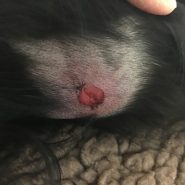
A DOG has died in Bournemouth after contracting Alabama Rot – a disease which has already claimed the life of another dog in Dorset this year.
The case is one of seven confirmed recently in England and Wales by Hampshire vets Anderson Moores, who are specialists on the disease.
The dog had been walked in the Slades Farm and Talbot Woods area before it died on Tuesday, March 28.
It follows the death of Cocker Spaniel Maggie, from Bearwood, last month. Her heartbroken owner, Cathy Moss, has been dog walking in Verwood Forest, Canford Heathand Knighton Heath before she died.
David Walker, head of medicine at Anderson Moores, said they strongly suspected an environmental trigger behind the disease – known as idiopathic cutaneous and renal glomerular vasculopathy (CRGV) – although this has yet to be confirmed.
“We’ve worked very hard to unravel the mystery of Alabama Rot. We’ve done a lot of walks with a botanist from the Natural History Museum in areas where cases of the disease have been confirmed,” he said.
Anderson Moores has organised the first Alabama Rot conference in May where they will meet with human medical scientists, vets, and university academics to discuss the disease and how to stop it spreading further.
“The problem is that it’s a small disease – we’ve lost 94 dogs in the UK and Ireland since 2012 – it’s not a major disease like heart disease or cancer, so it’s harder to get funding,” Mr Walker explained.
“We’ve made huge strides with our research, but everyone wants an answer and it’s going to take time and money.”
Alabama Rot causes damage to blood vessels of the skin and kidney. An early sign of the disease is unexplained redness, sores or swelling of the skin – particularly on the paws or legs – but they can also be found on the body, face, tongue or mouth.
The disease can go on to cause fatal kidney failure and signs include vomiting, reduced hunger and tiredness.
The fatality rate is high, with only 15-20 per cent of dogs surviving the disease.
The breeds which have been affected most include Labradors, English Springer Spaniels, Cocker Spaniels, Whippets, Flatcoated Retrievers, Hungarian Vizlas, and Border Collies.
However, Mr Walker stressed any breed could be at risk.
He added: “The really tough thing is that it’s not a disease of an old dog – often dogs in the prime of their life get it.
“It’s hard to give preventative advice so all we can say is be vigilant, and if you notice an unexplained sore on your dog, take it to the vet as it’s better to be safe than sorry.”